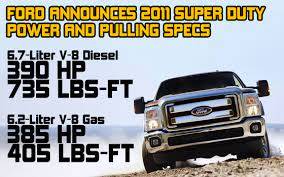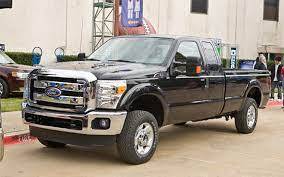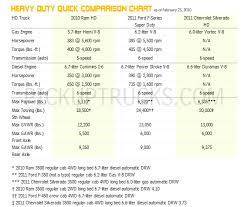Ford Announces 2011 F-Series Super Duty Power and Pulling Specs

After holding our breath for five months, Ford has finally released the official power ratings for its 2011 F-Series Super Duty pickups. They are very impressive.
The all-new 2-valve SOHC 6.2-liter gasoline V-8 is rated at 385 horsepower (at 5,500 rpm) and 405 pounds-feet of torque (at 4,500 rpm), and the all-new 4-valve OHV 6.7-liter Power Stroke V-8 turbodiesel is rated at 390 hp (at 2,800 rpm) and an earth-shaking 735 pounds-feet (at 1,600 rpm) in the F-250, F-350 and F-450 pickups. The F-450 and up chassis cabs are rated at 300 hp and 660 pounds-feet.
Let’s put these powerful numbers in perspective.
For the gassers, the outgoing 2010 Super Duty’s standard 5.4-liter gas V-8 is rated at 300 hp and 365 pounds-feet, and the optional 6.8-liter V-10 is rated at 362 hp and 457 pounds-feet. So the new 6.2-liter V-8 has more horsepower than either of the old engines and just misses splitting the difference in torque between the 5.4-liter and 6.8-liter, with two fewer cylinders than the massive 6.8-liter.
We can also compare the 6.2-liter V-8 in the Super Duty against its application in the 2010 Ford F-150 SVT Raptor. The 6.2-liter V-8 in the Raptor is rated at a larger 411 hp and 434 pounds-feet.
The power numbers are larger in the light-duty pickup for two reasons, according to Chris Brewer, Super Duty chief engineer.
“The main reason is that when the truck goes over 8,500 pounds [gross vehicle weight rating], the SAE [horsepower and torque] rating method changes,” Brewer said. “We can’t get the same horsepower and torque out of it [like we can in the F-150].”
The 6.2-liter V-8 in the Super Duty also uses a different camshaft from the light-duty version, which, some may recall, is the same approach Ford uses to make 500 hp in the FR Raptor XT version of the 6.2-liter V-8.
Before we compare the old and new diesel power ratings, you may be wondering why there are two sets of power figures for the 6.7-liter diesel. Again, gross vehicle weight rating plays a role.
The Environmental Protection Agency requires different emissions testing procedures depending on the gross vehicle weight rating, which leads to different power ratings. So-called “heavy-duty light trucks” below 14,000 pounds GVWR are tested using a chassis dynamometer; medium-duty vehicles whose GVWR is 14,000 pounds or greater are tested using an engine dyno.
Comparing the oil burners, the old chassis-certified 6.4-liter Power Stroke diesel V-8 is rated at 350 hp and 650 pounds-feet, so we’re seeing a substantial jump in power by 40 horses and 85 pounds-feet from Ford’s in-house designed and built 6.7-liter V-8. The dyno-certified 6.4-liter is rated at 325 hp and 600 pounds-feet, or 25 hp more and 60 pounds-feet less than the 6.7-liter.
“We’re real pleased about the numbers for the new gas and diesel engines,” Brewer said. “It’s a big win for customers and us.”
Brewer also broke down the 2011 Super Duty’s new towing and hauling capabilities. Last week, GM announced its new 2011 Chevrolet Silverado 2500 and 3500 pickups would have best-in-class towing and hauling, pending the release of Ford’s numbers. Ford is now claiming those numbers and bumping them significantly higher over the 2010 Super Duty.
The F-250 and F-350 single rear-wheel trucks can tow up to 14,000 pounds conventionally and haul 4,050 pounds and 4,500 pounds, respectively. The F-350 dual rear wheel is rated to pull 16,000 pounds conventionally and up to 21,600 pounds using a fifth-wheel hitch. It can haul payloads up to 6,520 pounds.
Maximum towing requires a standard 3.73 or optional 4.10 rear axle. For those interested in prioritizing fuel economy or looks over towing, the Super Duty can be ordered with 20-inch wheel s and a 3.55 final drive ratio or a tall 3.31 ring and pinion, which was introduced as an option in 2010.

As we mentioned in our first look at the 2011 Super Duty, Ford has made significant frame changes to the F-450 pickup in response to owner requests for better fuel economy. The result is a lighter truck with a double-digit percentage improvement in fuel economy, and it tops out at 13,050 pounds GVWR for 2011 versus 14,500 pounds GVWR in the 2010 model. Maximum towing is 24,400 pounds, down marginally from 24,600 pounds, and maximum hauling is 4,920 pounds, down from 6,100 pounds.
The F-450’s top speed has also been raised. The old 19.5-inch wheels have been dropped because their tires were rated up to only 80 mph. New 17-inch wheels and tires raise the 2011 F-450’s top speed above 90 mph. The two-wheel-drive version has also been dropped. The F-450 is only available with four-wheel drive.
All the towing and hauling improvements are due to the new gas and diesel engines and all-new six-speed transmission, Brewer said. The frame and suspension components are virtually identical to the 2010 Super Duty lineup except for the F-450, which we noted earlier.
The 6.7-liter diesel also uses a unique approach to staying cool while working hard to help increase the numbers. It has two separate cooling systems, each with its own radiator and water pump. The primary cooling loop cools the engine while the secondary loop controls the temperatures of the exhaust gas recirculation, fuel and transmission coolers and a brand-new air-to-water charge air cooler that replaces the previous air-to-air intercooler.
In the future, we’ll be interested to check back and see if Ford’s towing ratings change once the proposed SAE J-2807 trailer towing standards are ratified by an alliance of truck manufacturers that includes Ford, General Motors, Chrysler, Toyota and Honda and several leading trailer and hitch makers.

“We are actively involved in the SAE Trailer Tow Committee that is developing the J-2807 standards,” Ford spokeswoman Anne Marie Gattari said. “Final revisions to the standard are in progress with a ballot vote planned for this quarter. The standard will be implemented by all OEMS starting in 2013 [model year]. Ford’s current plan is to follow in that direction at that time.”
With all of the power and pulling improvements, Ford hasn’t left fuel economy out of the equation. “For the pickups, we’ll see an 18 percent improvement in fuel economy and 25 percent in the chassis cabs,” Brewer said.
Brewer didn’t provide specific numbers since HD pickups aren’t required to carry EPA fuel economy ratings. We’ll take his word for it until we can test the trucks.
We’ll be driving the new Super Duty pickups soon. We can’t wait to share our first impressions next month. Also, we’ll be waiting to hear GM’s horsepower and torque figures for the new “LML” 6.6-liter Duramax V-8 diesel to see if Ford will hang on to it best-in-class engine ratings.
Cars.com’s Editorial department is your source for automotive news and reviews. In line with Cars.com’s long-standing ethics policy, editors and reviewers don’t accept gifts or free trips from automakers. The Editorial department is independent of Cars.com’s advertising, sales and sponsored content departments.
Featured stories




